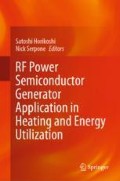Abstract
The generation of microwave energy by solid-state semiconductors has recently been acknowledged as viable, and perhaps preferable. The reason for this is that solid-state technology allows for the capability for control over electromagnetic properties and characteristics of the microwave system [1]. These properties include the phase, the amplitude, and the frequency. With this amount of control, it is expected, and even demonstrated, that the two main characteristics of microwave generation and delivery system (efficiency and heating uniformity) can be improved significantly. It is not enough, however, to simply control and manipulate the properties mentioned above; there must be a feedback system that would allow this to be done in an intentional manner. There is yet another important difference between magnetron and solid-state technology, namely the ability to measure and respond to forward and reflected power levels. A typical solid-state RF (SSRF) generation system is comprised of a small-signal generation section, a high-power amplifier connected to a heat sink, and a power supply to drive the respective electronics [2]. The feedback, which is typically built into the power amplifier, then allows for the monitoring of the frequency, the phase, and the power levels. With these parameters, and the ability to manipulate them, it is not difficult to imagine that algorithms could be developed that could control these properties in a way which is responsive to the load contained within the cavity.
Access this chapter
Tax calculation will be finalised at checkout
Purchases are for personal use only
References
Yakovlev VV (2016) Computer modeling in the development of mechanisms of control over the microwave heating in solid-state energy systems. Ampere Newsl 89:18–21
Werner K (2015) RF energy systems: realizing new applications. Microw J: 22–34
Waldron RA (1970) Theory of guided electromagnetic waves. Van Nostrand Reinhold Company, London
Jackson JD (1999) Classical electrodynamics, 3rd edn. John Wiley & Sons Inc., Hoboken
COMSOL Multiphysics, v. 5.3. www.comsol.com
Computer simulation technology. www.cst.com
Datta A (2001) Handbook of microwave technology for food application. Marcel Dekker Inc., New York
http://products.geappliances.com/appliance/gea-support-search-contentID=21531
Ellison WJ (2007) Permittivity of pure water, at standard atmoshpheric pressure, of the frequency range 0–25 THz and the temperature range 1–100 C. J Phys Chem Ref Data 36:1
Ellison WJ, Lamkaouchi K, Moreau JM (1996) Water: a dielectric reference. J Mol Liq 68:171279
Hopper CS, Grimaldi G, Marra F, Prochowski J, Sclocchi M (2019) Targeted food heating using a solid-state microwave oven. In: Proceedings of the 53rd annual microwave power symposium. Las Vegas, Nevada, USA
https://www.nxp.com/products/rf/rf-power/rf-cooking/smart-cooking-concept:RF-SMART-COOKING-PG
Laug OB (1977) Evaluation of a test method for measuring microwave oven cooking efficiency, NBSIR 77-1387. Institute for Applied Technology, National Bureau of Standards, Washington D.C.
Household microwave ovens-Methods for measuring performance. International Electrotechnical Commission, IEC 60705, Geneva, Switzerland (2010)
Pitchai K, Birla S, Suggiah J, Jones D (2010) Heating performance assessment of domestic microwave ovens. In: 44th annual symposium of the International Microwave Power Institute
Yakovlev VV Effect of frequency alteration regimes on the heating patterns in solid-state-fed microwave cavity. J Microw Power Electromagn Energy 52(1):31–44. https://doi.org/10.1080/08327823.2017.1417105
Hopper CS, Grimaldi G, Mannara G, Marra F, Sclocchi M (2018) Analysis of food heating in a multi-source solid-state microwave oven. In: 52nd annual symposium of the International Microwave Power Institute
Wesson R (2016) Solid-state microwave cooking. AMPERE Newsl 89
Werner K (2016) RF energy alliance: advancing next generation microwave heating applications. AMPERE Newsl 89
Durnan G (2016) Solid-state heating with advanced RF-power solutions. AMPERE Newsl 89
Author information
Authors and Affiliations
Corresponding author
Editor information
Editors and Affiliations
Rights and permissions
Copyright information
© 2020 Springer Nature Singapore Pte Ltd.
About this chapter
Cite this chapter
Hopper, C. (2020). RF Cooking Ovens. In: Horikoshi, S., Serpone, N. (eds) RF Power Semiconductor Generator Application in Heating and Energy Utilization. Springer, Singapore. https://doi.org/10.1007/978-981-15-3548-2_6
Download citation
DOI: https://doi.org/10.1007/978-981-15-3548-2_6
Published:
Publisher Name: Springer, Singapore
Print ISBN: 978-981-15-3547-5
Online ISBN: 978-981-15-3548-2
eBook Packages: EngineeringEngineering (R0)

